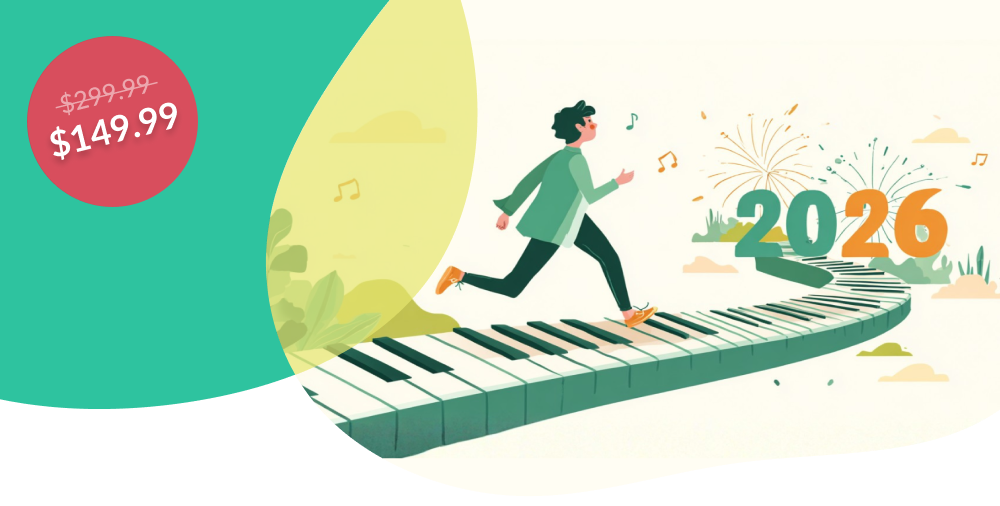Tone deafness is exceedingly rare. The only reason you might think that you are tone deaf, meaning you can’t hear the difference between tones, is because you have never been taught how to hear pitches properly. At some point, somebody taught you how to recognize colors and shapes. But, they probably did not teach you how to hear intervals or a major triad. All it takes is time and training.

Start with the basics
If you want to improve your pitch recognition skills, start with the basics. We experience pitch on a spectrum from lower notes (think engine sounds or deep, earthy sounds) to higher notes (think violins, trumpets, flutes, etc.).

Test yourself
Sit down at the piano and find middle C. If you need some assistance finding middle C, review these grand staff notes for guidance. Once you feel comfortable with middle C, close your eyes and play keys on the right hand side of middle C. Do these keys sound higher or lower in pitch compared with middle C? Next, play keys to the left of middle C. Do these notes sound higher or lower in pitch compared to middle C?
Which is which?
The notes to the right of middle C should sound higher in pitch and the notes to the left of middle C should sound lower in pitch. If you can hear this difference, good news! You are not tone deaf.
Phone a friend
Now, call up all your friends and share with them the great news that you are not tone deaf. Invite one of them over to your house and have them test you. Ask your friend to sit at the piano and play middle C. If they don’t know where middle C, then you have an excellent opportunity to share your piano knowledge and pass on the benefits of music education.
Have your friend follow similar steps as you did. Ask them to play notes above or below middle C while you have your back turned so you cannot see which direction their hands are moving. Then identify which notes are above middle C (higher in pitch) and which notes are below middle C (lower in pitch).

What is tone deaf?
You may be wondering exactly what does tone deaf mean? True tone deafness is called amusia. There are two types of amusia: acquired amusia and congenital amusia. Acquired amusia is usually the result of some type of brain damage. Congenital amusia means you are tone deaf from birth.
Tone deaf meaning
If you are really worried about it, there is tone deaf available online for you to test yourself. This tone testing tool is free and easy to complete.
Hearing is a superpower
The ability to hear musical pitches is a sort of superpower, one that we can all train ourselves in. Just as you can see different colors, so too can you hear pitches. You just need to practice because it is likely not a skill that anyone told you about previously.
Lay the foundation
Here is a practical way to lay a solid foundation. Sit down at your piano. Sing or hum the most comfortable pitch for your voice. It will feel like the natural resting place for your voice. Once you have found this place, match this pitch on the piano. It might be the C below middle C, the F below middle C, or the E or G above middle C.
Consistency is key
Now, everytime you sit down to practice the piano, or better yet, first thing in the morning when you wake up, close your eyes and try to remember this pitch inside your head, sing it, and then play the pitch on the piano to check yourself. Overtime, you will develop a certain type of auditory muscle memory and be able to recall this pitch at any moment. This is the foundation of building the ear training skill of relative pitch.
Keep building
Once you can comfortably remember a certain pitch, start to expand your skills beyond that. Learn how to hear intervals, chords, melodies, and rhythms. There are myriad ways to practice these skills – get creative yourself or find some apps or online piano lessons to help guide your practice.
Hearing intervals
Perhaps the easiest way to go after learning to memorize a foundational pitch is to practice singing and memorizing piano intervals. Here is a way to practice.
- Begin from your home pitch and try to sing a major second (2 semitones) above. Once you think you have found it, check yourself with the piano.
- Next, try to sing a major third above (4 semitones) then check yourself with this piano.
- Then, try to sing a perfect fourth (5 semitones) and again check yourself.
- Continue this until you make it up to an octave. Then go in the reverse direction.
- After you practice this, you can try to sing harmonic intervals on the piano. Play a major second on the piano and try to sing both pitches, one after another. Then try a major third, perfect fourth, perfect fifth, etc.
There are tens of different interval trainers available online or as phone apps.
Hearing chords
Chords are simply combinations of intervals, so once you can hear basic intervals, try to learn to identify chords. Since you should already have a solid grip on the basic piano chords, this should be relatively easy for you.
The simplest way to do this is probably to just listen to music. Put on one of your favorite pop songs and see if you can identify major and minor chords by ear. Again, there are tens of different chord training apps and programs available both online and on the phone. Ear training tools are extremely accessible if you take a minute to look around.

Conclusion
Don’t accept the feeling that you are tone deaf. True tone deafness is exceedingly rare and you would likely know it from a young age. What is more likely is that you, like many others, have not been exposed to ear training and pitch recognition in the same way that you have been exposed to other sense training mechanisms like color and shape. Ear training takes time to master, but if you start today, Skoove can help you all the way!
Author of this blog post

Eddie Bond is a multi-instrumentalist performer, composer, and music instructor currently based in Seattle, Washington USA. He has performed extensively in the US, Canada, Argentina, and China, released over 40 albums, and has over a decade experience working with music students of all ages and ability levels.















